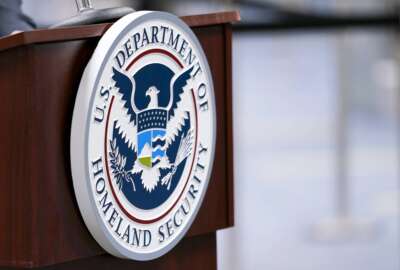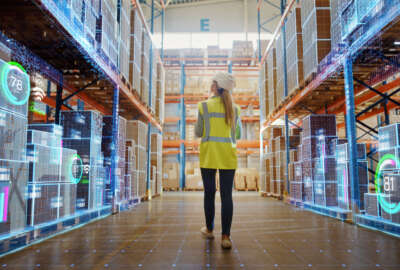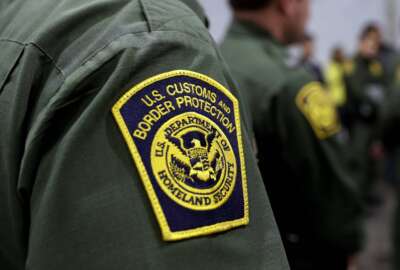Even Customs and Border Protection is getting into the green movement
U.S. Customs and Border Protection seeks to strengthen enforcement against what it calls environmental bad actors and to foster a greener worldwide supply chain.
Best listening experience is on Chrome, Firefox or Safari. Subscribe to Federal Drive’s daily audio interviews on Apple Podcasts or PodcastOne.
U.S. Customs and Border Protection has launched what it calls a green trade strategy. Among other things, it seeks to strengthen enforcement against what it calls environmental bad actors and to foster a greener worldwide supply chain. AnnMarie Highsmith is CBP’s executive assistant commissioner for Trade. She talked to the Federal Drive with Tom Temin.
Interview transcript:
Tom Temin: Let’s begin with how CBP can influence trade towards the green area. I guess my understanding was CBP facilitates cargo coming in and going out, maintains the data and ensures against prohibited cargo. But how else can you get deeper into the whole trade issue in that sense?
AnnMarie Highsmith: CBP is uniquely positioned to have a significant impact on the future of environmental sustainability in the United States. As part of our trade enforcement mission, we develop the green trade strategy in order to leverage our influence and authorities to support environmentally sustainable practices that will benefit the environment and the economy, while strengthening the resilience of global supply chain. So with the green trade strategy, we hope to set an example for industry and customs authorities around the world to follow, as we truly believe that sustainability and innovation are the future of trade. So the impetus for launching the green trade strategy really can be summarized into three parts. The first is that addressing climate change is a priority of the Executive Branch. The administration has issued multiple executive orders and policy statements that are focused on climate issues. And the green trade strategy supports the administration’s whole of government approach to addressing climate change. It also aligns with climate framework for the Department of Homeland Security. Second, climate change, and to your point, climate change and natural resource crimes have a clear nexus to our trade mission. Recent studies have estimated that global supply chains may account for as much as 80% of the world’s total carbon emissions. So the cumulative impacts of climate change will affect our essential functions and the supporting infrastructure.
Tom Temin: Well, let me ask you about that. The supply chains account for 80% of emissions. What does that mean? I mean, the ships go back and forth, they have engines, they have smokestacks. Is that what you mean? Or is that the materials that are moving around?
AnnMarie Highsmith: That’s really both. It’s what comes to the United States, what merchandise comes to the United States and how it gets here, including how it processes through our own customs facilities.
Tom Temin: Well, let me ask you this then: Most of the trade in terms of the trade imbalance in the dollars is from China, which is the world’s biggest emitter of carbon into the atmosphere, and is not really doing a heck of a lot to mitigate that. And so how do we balance the fact that we can’t live without Chinese goods coming in, and yet that’s the biggest carbon source? How do you green up that piece of trade?
AnnMarie Highsmith: How do we green up that piece of trade? We seek to position ourselves in a leadership role from a global perspective to work through our international trading partners, international trade agreements that already include provisions for environmental provisions. The USMCA agreement, our U.S.-Vietnam timber agreement, U.S.-Peru Trade Promotion act, then to establish best practices globally so that our all of our trading partners get on board and see the importance and see actually not just the benefit for climate change, but also the financial benefits in running a sustainable green supply chain.
Tom Temin: And what would environmental greater enforcement by CBP look like? Give us a couple of examples of the types of thing that you have the power to enforce.
AnnMarie Highsmith: So right now we’re using our existing authorities to really, what we like called defund the unlawful trade of wildlife that’s covered under laws such as the Lacey Act, Endangered Species Act, Magnuson-Stevens Fishery Conservation and Management Act, CITES [Convention on International Trade in Endangered Species of Wild Fauna and Flora], and we’re working with our NGOs and international organizations to target environmental crime. So we’re talking about illegal logging, timber trade, the endangered fish, combating money laundering related to the illicit trade of minerals such as diamonds and gold.
Tom Temin: All right, and there’s another priority in your goal, and that has to do with research in green trade, some of the areas you’re going to be looking at.
AnnMarie Highsmith: We’re working to survey our international organizations and governments, such as the World Customs Organization and the European Union and engage with our industry partners, nongovernmental organizations and academic institutions to solicit ideas and perspectives on incentivizing the adoption of carbon-reducing practices. Right now we have a really interesting project going on with the World Wildlife Federation and Virginia Tech to develop a targeting methodology for illegal logging and timber trade. And we’re collaborating with Global Fishing Watch to deter illegal fishing by improving visibility into fishing locations. And we’re also working with an NGO sustainable fisheries partnership on a project in the Baja California protected zone to save the endangered totoaba fish and the vaquita porpoise.
Tom Temin: Interesting. We’re speaking with AnnMarie Highsmith, she’s executive assistant commissioner for Trade at U.S. Customs and Border Protection. And the strategy and the carrying out of it will have to take place at the local level where CBP operates at all of the ports of entry and so forth. How do you push this down? And what do you see possibly changing in the practice of the officers on the line there that deal with trading partners day in day out?
AnnMarie Highsmith: Certainly. We have already taken steps to facilitate the movement of trade which by providing benefits and incentives to promote environmentally friendly trade practices. Our unified cargo processing, and free and secure trade or FAST programs have already resulted in an 85% reduction in idling-related emissions at the land border ports of entry. Additionally, we have a program AQUA Lanes [Advanced Qualified Unlading Approval], which allows trusted traders and trusted shippers at domestic seaports to clear crews prior to vessel unlading. And this has resulted in a reduction of approximately 5,844 vessel idle hours, and a decrease in total emissions at the U.S. ports. So we have those programs for facilitation but we’re also working to green our local facilities through the Bipartisan Infrastructure Law. We have 26 projects underway that will upgrade our land border ports of entry to be more sustainable and energy efficient.
Tom Temin: That’s really a big point that you made with respect to truck idling and ship idling because sometimes these trucks kind of a common practice for trucks at transfer stations to idle sometimes for hours and hours, sometimes all night. And if you add up all those diesel trucks, it could be up to 6,000 hours change by the time we’re done talking.
AnnMarie Highsmith: Correct.
Tom Temin: And when ships themselves – so that’s part of this also then the emissions of the shipping vessels, which can be pretty considerable.
AnnMarie Highsmith: Yes, we’re taking a really holistic approach. All the modes of international trade and travel will be part of our green trade strategy. We do have the opportunity because as we noted at the top of this, 80%, up to 80% of total carbon emissions being related to global supply chains, we have the ability to move the needle and to look broadly at the sources of environmental degradation coming from our operations.
Tom Temin: And just a final question you mentioned, of course, CBP is part of Homeland Security. So there’s an overarching drive here related to the management agenda and to the administration priorities at the DHS level?
AnnMarie Highsmith: Yes, absolutely. DHS has its own climate change framework, and we are actively participating in that program. One interesting part of that program is the climate change professionals program which allows us to carve out specific roles and internships for individuals who are interested and motivated to work with us on this implementing this strategy. Also, DHS has a national climate resilience prize competition that we are looking to promote green trade innovation among our industry partners.
Tom Temin: All right, sounds like you’ve got a major project. This is not a short term thing, is it?
AnnMarie Highsmith: No, sir. We think that this will be an agency priority for many years into the future.
Copyright © 2025 Federal News Network. All rights reserved. This website is not intended for users located within the European Economic Area.
Tom Temin is host of the Federal Drive and has been providing insight on federal technology and management issues for more than 30 years.
Follow @tteminWFED






